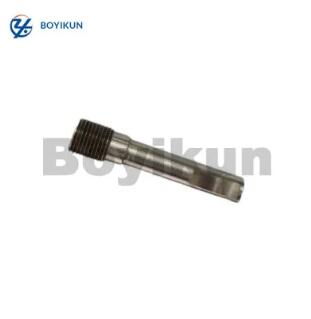Understanding Stainless Steel Precision Threaded Turned and Milled Parts – Essential Components in Modern Engineering
2024-09-05
Stainless steel precision threaded turned and milled parts are at the heart of many modern engineering applications. From automotive to aerospace and industrial machinery, these parts play a critical role in ensuring that complex systems function smoothly and efficiently. In this blog, we’ll dive into the details of what makes these precision components unique, how they are made, and why they are essential in various industries.
What Are Stainless Steel Precision Threaded Turned and Milled Parts?
Stainless steel precision threaded turned and milled parts refer to custom-designed components that are manufactured using advanced CNC (computer numerical control) machining processes. These parts typically feature intricate threads and require a high degree of accuracy, which is achieved through the turning and milling of stainless steel materials.
- Turning: This process involves rotating the material while a cutting tool removes layers of metal to create cylindrical parts or specific shapes.
- Milling: This method uses rotary cutters to remove material and create precise flat surfaces, grooves, or complex geometries.
- Threading: Threading involves cutting a helical groove on the surface of cylindrical parts to create screws, bolts, or other fasteners.
These processes are used to produce components with tight tolerances, ensuring that the parts fit and function perfectly in their intended application. Stainless steel is often the material of choice due to its corrosion resistance, strength, and durability, making it ideal for parts that will be exposed to harsh environments.
Key Characteristics of Precision Threaded Turned and Milled Parts
1. High Precision: One of the primary characteristics of these components is their precision. CNC machining allows for parts to be manufactured with incredibly tight tolerances, ensuring that they meet exact specifications.
2. Corrosion Resistance: Stainless steel is renowned for its corrosion resistance, which makes it a perfect material for parts exposed to moisture, chemicals, or extreme temperatures. This resistance ensures the longevity and reliability of the parts, even in demanding conditions.
3. Strength and Durability: Stainless steel offers excellent mechanical properties, including high tensile strength and toughness. This makes it ideal for components subjected to mechanical stress, such as in the automotive or aerospace industries.
4. Versatility in Design: Thanks to the flexibility of CNC machining, stainless steel precision parts can be designed in various shapes, sizes, and complexities. From simple fasteners to highly intricate mechanical parts, the design possibilities are vast.
5. Threaded Features: Many of these parts are threaded, which allows them to be used as fasteners in assemblies. The threading process ensures that the parts can be securely attached, making them suitable for various applications, such as bolting, screwing, or joining parts together.
Manufacturing Process of Stainless Steel Precision Parts
The production of precision threaded turned and milled parts typically involves several steps:
1. Design: The process begins with a detailed design, usually created using CAD (computer-aided design) software. This design specifies the exact dimensions, shapes, and threads required for the part.
2. Material Selection: Stainless steel is chosen based on the part’s application requirements. There are various grades of stainless steel, each offering different properties in terms of strength, corrosion resistance, and machinability.
3. Turning: In CNC turning, a stainless steel bar or blank is rotated while a cutting tool removes material to achieve the desired shape. This is especially useful for creating cylindrical parts such as shafts, screws, or bushings.
4. Milling: CNC milling is used to cut flat surfaces, grooves, or intricate geometries. The material is clamped onto a table, and the milling machine removes material using rotary cutters.
5. Threading: The final step is threading, which involves creating helical grooves on the component. Threading is essential for fasteners or parts that need to be screwed or bolted into assemblies.
6. Quality Control: Precision parts must undergo rigorous quality checks to ensure they meet the required specifications. This may involve measuring the dimensions, checking thread integrity, and inspecting the surface finish.
Applications in Various Industries
- Automotive: Stainless steel threaded turned and milled parts are widely used in automotive components, such as engine parts, fasteners, and exhaust systems.
- Aerospace: In the aerospace sector, these parts are essential in the construction of aircraft engines, landing gear, and structural components, where precision and durability are critical.
- Medical Devices: Precision components made from stainless steel are also used in medical devices, such as surgical instruments and implants, due to their biocompatibility and resistance to sterilization processes.
- Industrial Machinery: Many industrial machines rely on stainless steel precision parts for their durability and ability to withstand high levels of mechanical stress.
Conclusion
Stainless steel precision threaded turned and milled parts are vital components in many industries, offering unmatched precision, strength, and corrosion resistance. Their versatility and durability make them an ideal choice for applications ranging from automotive and aerospace to medical devices and industrial machinery. The advanced CNC machining processes used in their production ensure that these parts meet the highest standards of quality and performance.



